Barry’s Harmony Primer
Comping is the art of accompanying a soloist with a harmony instrument like piano or guitar. This primer will introduce you to some of the ingredients of Barry's comping. It is a perfect representation of how to interact with the rhythm section in a pure bebop style, and will provide strong support for the soloist both rhythmically and harmonically.Comping chords are small, self contained packets of small chords (3, 4 or 5 notes) with good voice leading, and expressing a concise rhythmic figure. Many of the voicings are derived from the major or minor sixth diminished scales and often include the root of the underlying chord.Most importantly, Barry's comping chords are never static, and often move in a melodic way, switching between inversions or moving between close and open positions.This primer is intended to introduce some very simple comping patterns, based on Barry's harmonic principles.The first task is to find ways of moving voicings over given chords, in a way that creates melodic, harmonic and rhythmic interest.PART 1: Moving chords along a scale
The simplest way to create movement over a chord is to advance the chord up and down the scale that the chord belongs to. For example, C major 7 belongs to the scale of C major, so you can advance the chord up and down the C major scale (with a rhythmic pattern) to create movement:
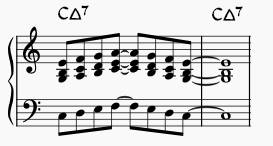 Listen
Listen
You can also extract the portion suitable for moving over a minor 7 chord. For example, since D-7 also belongs to the key of C, you can advance the chord up the C major scale with a rhythmic pattern like this:
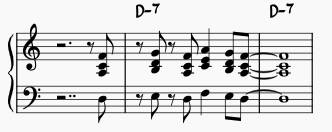 Listen
Listen
Here is the portion suitable for moving over a dominant 7 chord. Start on the half diminished chord on the seventh degree of the major scale and move it down to the fifth degree. In the key of C, it would be this:
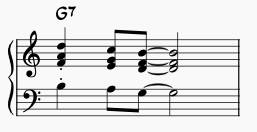
We can obtain a more colorful version of the dominant 7 chord (with extensions and alterations) by advancing it along a different scale called the sixth diminished scale. The sixth diminished scale not only enriches and moves dominant 7 chords, but also allows for movement within the major 7 and minor 7 chords discussed above. It can also be used to create movement within m6 and m7b5 chords.PART 2: The Sixth Diminished ScaleThe core of Barry’s system revolves around the major and minor sixth diminished scales.
Let's start by looking at the major sixth diminished scale. This is a major scale with an added #5:

If we construct a C major 6 chord on the first note and move this chord up the scale, we get an alternation of C6 and Bdim7 chords, in various inversions:
 Listen:
Listen:
This movement is essentially an alternation of Tonic chords and Dominant chords, since diminished 7 chords are like dominant 7 chords with a b9. The effect is of tension-release-tension-release.In order to engage both hands without doubling notes, you should practice this scale in drop 2 position, assigning the drop 2 note to the left hand:
 Listen:
Listen:
Primer Exercise n. 1: Can you play the C6/dim scale of chords up and down in both close and drop 2 positions?
Yes
No
You can use the above chord sequence to comp over major 6 and minor 7 chords. You can start in any place in the scale of chords, and keep advancing the chords along the scale until the next chord arrives.
EXPLAINER: The C6/dim scale works for C6 and A-7, because C6 = A-7 in first inversion.
PART 3: Application to SongsNow that you can play the C6/dim scale of chords, let's see how we can use it to comp over common chord progressions found in songs, like: Bm7b5 --> E7b9 --> AmDm7b5 --> G7 --> C Dm7 --> G7 --> CTo create chord voicings that correspond to m7b5 and mM7 (tonic minor), start with a C major 7 (drop 2), then move it up a C6/dim scale:
 Listen
Listen
You can extract portions of this progression to generate common chord progressions. For example, Bm7b6 --> E7b9 - Am:
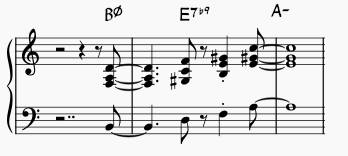
Be sure to practice all chord progressions with a swinging rhythmic pattern.Also, Dm7b5 --> G7 --> C:
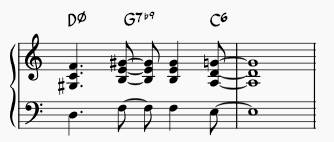 Listen
Listen
Next, Dm7 --> G7 --> C. This can be realized in two ways.Method 1: Use the Dm7 voicing in PART 1 combined with Fdim7 (= Bdim7 in 2nd inversion) and C6 voicings in PART 2:
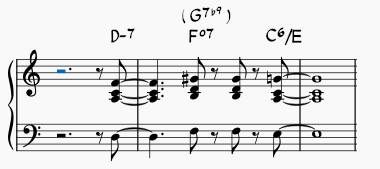 Listen
Listen
Method 2: Use the Dm7 voicing in PART 1 combined with the G7b9 and C6 in PART 3:
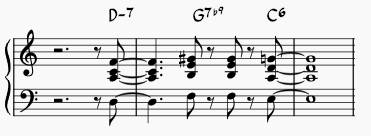 Listen
Listen
Since these examples are all in C major or A minor, you will have to transpose the voicings to other keys in order to apply them to various songs. The most expedient way to do this is to memorize the shapes. For example: G7b9 corresponds to a major triad in 2nd inversion a minor 3rd below G, with the 7th in the bassC6 corresponds to 4 notes stacked in 4ths, starting on the 3rd of C6 PART 4: BorrowingBorrowing involves playing a target chord (say C6), and substituting 1 or more chord notes with other notes in the underlying scale. These are called “borrowed” notes because they quickly resolve to the original notes in the target chord.
Here's and example on a voicing that Barry often used. First play the voicing up and down the C major scale:
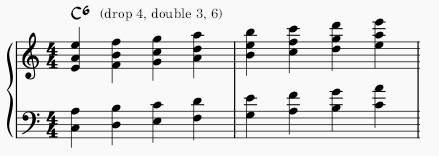 Listen
Listen
Primer Exercise n. 3: Can you play the drop 4 double 3 6 voicing up a C major scale?
Yes
No
Next, borrow the 2 non-chord notes above the 6th of the chord. Do this for each chord up the scale. Then resolve both notes back down to the 6th.
 Listen:
Listen:
Watch this exercise in the Archive Video (performed with just 3 notes)
Primer Exercise n. 4: Can you borrow and drop both 6th notes in a drop 4 double 3 6 voicing up a C major scale?
Yes
No
Next, let's try borrowing from the sixth diminished scale. This time we'll use the voicing used in PART 3. Here's the scale of chords again:

Instead of thinking of the first chord as a C major 7, we can consider it a C6 chord with one borrowed note (B) waiting to resolve to A.The above scale of chords would then become:
 Listen:
Listen:
Primer Exercise n. 2: Can you borrow and resolve one note from the C6/dim scale for each chord in the scale? Yes No
You can assemble groups of chords that outline a harmonic progression, and use the borrowed notes to create some rhythmic interest, such as:
 Listen
Listen
Notice how the inner voice runs down the C6/dim scale.Here's another example of two chords from the C6/dim (drop 2, borrow 1) used for comping on a C6 chord:
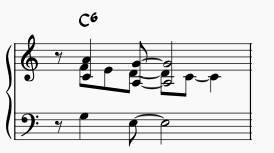 Listen
Listen
Part 5: Make it minorIn order to have all the necessary tools to play sixth diminished movements over all the chord changes in a song, we must include the minor sixth diminished scale. It is the same as the major version, but with a b3:
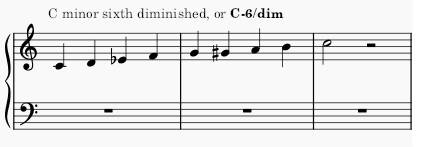 Listen:
Listen:
Here's the scale of chords on the C minor sixth diminished scale (with a drop 2 voicing):

Here's the scale of chords on the C minor sixth diminished scale with one borrowed note (with drop 2 voicing):

Here's the scale of chords on the C minor sixth diminished scale with one borrowed/resolving note (with drop 2 voicing):
 Listen:
Listen:
Notice how there are different ways of naming the resulting chords.
Primer Exercise n. 6: Can you play the C-6/dim scale of chords up and down?
Yes
NoFrom this progression you can extract:
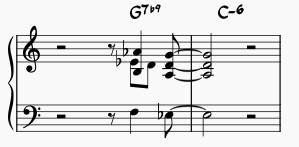
Part 6: SummarizingThe following is a summary of the voicings and their rhythmic patterns, for the various chords encountered in a jazz standard.
For major 7 chords, use these models:
MODEL 1 MODEL 2
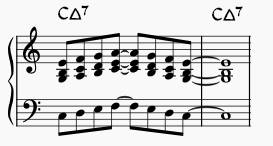 OR
OR 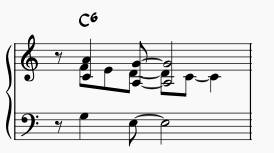
For minor 7 chords, use this model:
MODEL 3
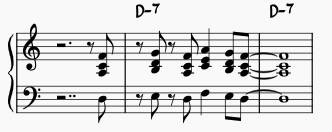
For dominant 7 chords that do not resolve to the Tonic, use:
MODEL 4
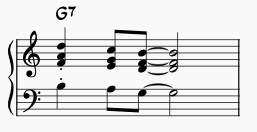
For V7 --> I, use one of these three models:
MODEL 5
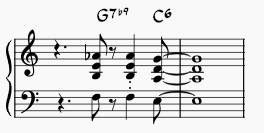
OR
MODEL 6
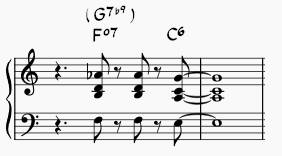
OR
MODEL 7

For major V7 --> Im, use one of these two models:
MODEL 8
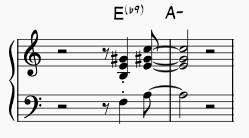
OR
MODEL 9
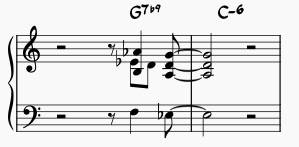
Memorize the shapes of these chords, because in PART 7 you will have to apply them to different keys. Part 7: Applying the sixth diminished scale of chords to songsSo far we have practiced the C major 7 diatonic scale of chords, the C major and C minor sixth diminished scale of chords, and we applied the "borrowing" technique to the C major diatonic scale and to the C major and C minor diminished scales. We then extracted portions of these scales of chords to use for comping on common chord progressions.
Let's see how to apply these extracted portions to comp on a jazz standard like All the Things You Are.
The parent scale of each group of chords is shown in the bass clef:Listen: 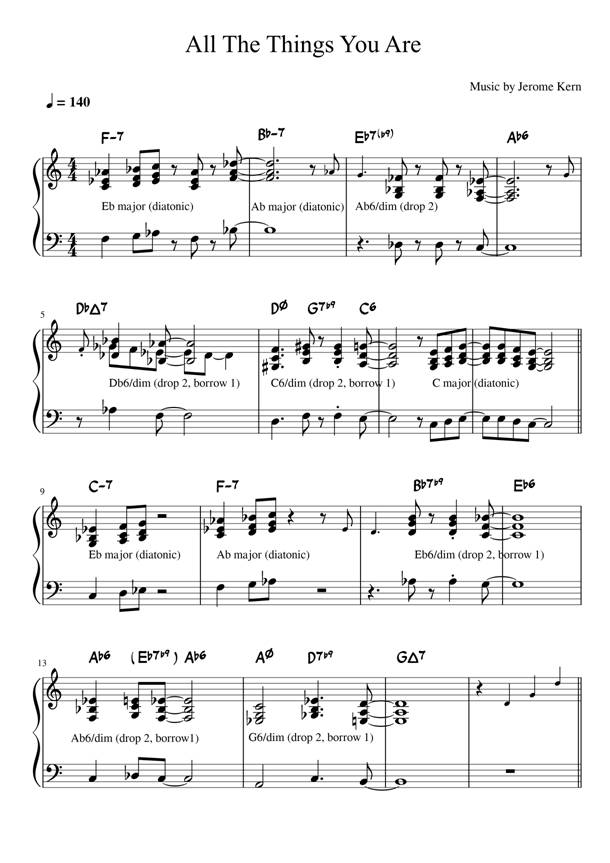
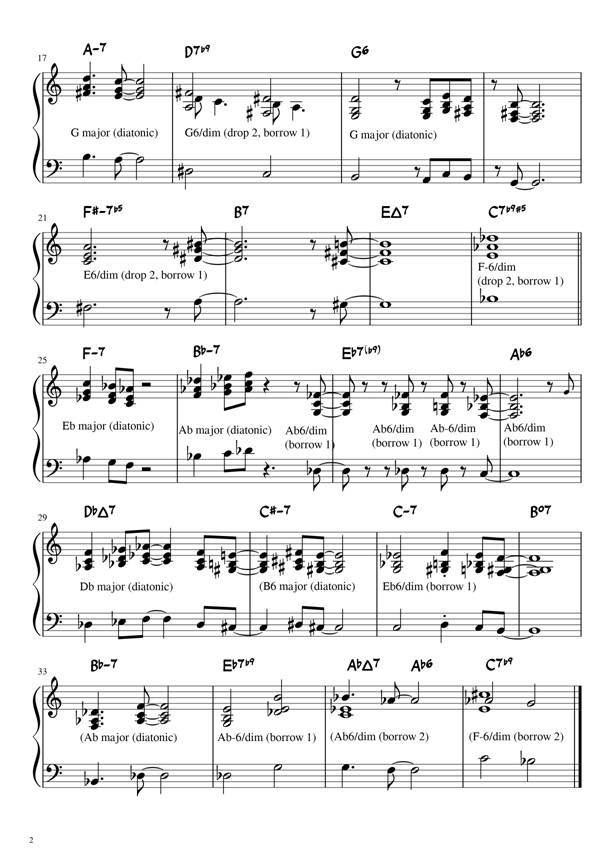
You now have all the tools to apply Barry’s sixth diminished harmonic system to comping on most jazz standards.
When you start practicing a new song, use the summary in PART 6 to determine which chord models you will use in each bar of the song. You will have to transpose the MODELS to adapt to different chord symbols in the new song. The best way to do this is to learn the shapes of each model.
Here's a cheat-sheet for finding the shapes in relation to the chord symbol.
|
Left Hand |
Right Hand |
Scale |
MODEL 1 |
Root of chord |
5th of chord: m3 - P4 |
Major |
MODEL 2 |
5th of chord. Then down m3 |
Major triad (2nd inv) on 4th of chord. Then 2 fourths from 6th of chord. |
Major |
MODEL 3 |
Root of chord |
5th of chord: m3 - P4 |
Major from 2nd |
MODEL 4 |
3rd of chord |
7th of chord: M3 - P4 |
Major from 5th |
MODEL 5 |
7th of chord |
Major triad (2nd inv) on 6th of chord. Then fourths from 6th of final chord |
6/dim of final chord |
MODEL 6 |
7th of chord. Then down half step |
3rd of chord: m3 - tritone. Then 6th of final chord: m3 - P5 |
6/dim of final chord |
MODEL 7 |
3rd of chord. Then b2 of chord. Then MODEL 5 |
7th of chord: M3 - P4. Then Major triad (2nd inv) on root. Then MODEL 5 |
6/dim of final chord |
MODEL 8 |
7th of chord. Then root |
Major triad (2nd inv) on 6th of chord. Then Aug Triad on 5th of chord. |
6/dim of relative major |
MODEL 9 |
7th of chord. Then down whole step |
Minor triad on b2 of chord. Then 2 fourths from 6th of final chord |
m6/dim of final chord |
Practicing the sixth diminished scales in all the keys related to a tune will help get the movements under your fingers, but learning the shapes will allow you to instantly find the voicings in scales you may not have practiced before.
For example, let's take the tune Just Friends. (open lead sheet)
Here is a breakdown of the MODELS and shapes in relation to this tune:
Left Hand Right Hand
C major 7 = MODEL 1 = Root of C 5th of C: m3 - P4
C-7 = MODEL 3 = Root of C-7 5th of C-7: m3 - P4
F7 = MODEL 4 = 3rd of F7 7th of F7: M3 - P4
G major 7 = MODEL 2 = 5th of G. Major triad (2nd inv) on 4th of G.
Then down m3 Then 2 fourths from 6th of G
Bb-7 = MODEL 3 = Root of Bb-7 5th of Bb-7: m3 - P4
Eb7 = MODEL 4 = 3rd of Eb7 7th of Eb7: M3 - P4
A-7 = MODEL 3 = Root of A-7 5th of A-7: m3 - P4
D7 = MODEL 4 = 3rd of D7 7th of D7: M3 - P4
B-7 = MODEL 3 = Root of B-7 5th of B-7: m3 - P4
E-7 = MODEL 3 = Root of E-7 5th of E-7: m3 - P4
A7 = MODEL 4 = 3rd of A7 7th of A7: M3 - P4
A-7 = MODEL 3 = Root of A-7 5th of A-7: m3 - P4
D7 = MODEL 4 = 3rd of D7 7th of D7: M3 - P4
Db7 = MODEL 4 = 3rd of Db7 7th of Db7: M3 - P4
D-7 = MODEL 3 = Root of D-7 5th of D-7: m3 - P4
G7 = MODEL 6 = 7th of G7. 3rd of chord: m3 - tritone.
Then down half step Then 6th of final chord: m3 - P5
Practice playing the MODELS over all the chords in the tune, and then play the comping chords for the entire tune with the appropriate rhythms, against a metronome.
Primer Exercise n. 8: Have you harmonized 'Just Friends' using only major and minor sixth/diminished chords?
Yes
No
Continue this exercise with many more standards. When you can apply these techniques with ease, move on to the Guide to Barry’s Harmonic Movement for Piano.
Happy practicing!